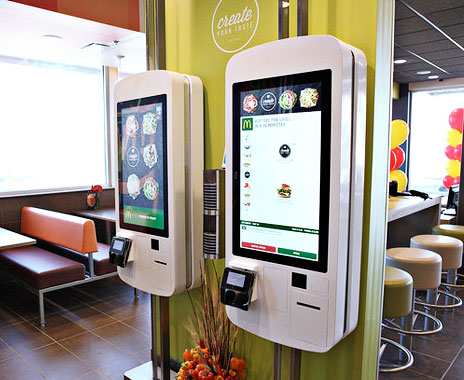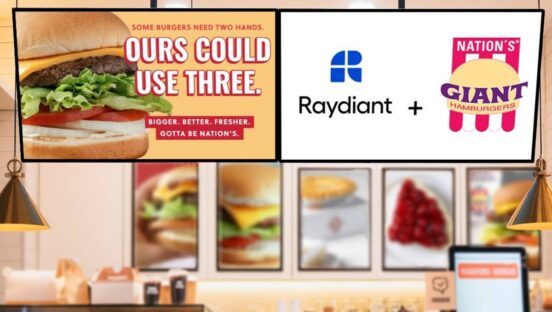McDonald’s has had a tough couple of years, with declining same-store sales and customer perception problems. But the company, led by new CEO Steve Easterbrook, might finally have some good news to hang its hat on: This week, McDonald’s enjoyed its highest stock price in nearly a year amid investor optimism.
The new “Create Your Taste” platform, a design-your-own burger operation that originally launched last year, might be partially to thank for the newfound optimism. McDonald’s recently announced plans to vastly expand Create Your Taste to thousands of stores.
Create Your Taste encourages customers to engage with tablet-like touch-screen kiosks, through which they can customize their quarter-pound burger with more than 30 ingredients, including a variety of buns, proteins, cheeses, toppings, and sauces. Mixing and matching these items allows for dozens of variations—a big change from simply requesting to hold the lettuce or add extra mayo. Initially offered in Australia in September 2014, Create Your Taste features additional menu toppings in the U.S., including guacamole, grilled mushrooms, onions, jalapeños, and pineapple, and additional proteins such as a fried egg and bacon. Sauces include aioli, garlic, and barbecue. Consumers can even order their sandwich with a lettuce wrap instead of a bun.
Servers deliver the finished open-face sandwich to the table, with the meat and warm toppings on the bottom bun and the cold toppings and sauces resting on the top bun.
In a May online video announcing company changes, Easterbrook said the company would work to attract more Millennials, who are increasingly opting for gourmet burgers and menu customization.
Customization isn’t just a top driver for Millennials; it’s also popular with consumers across all age groups, says Brian Darr, managing director at Datassential, a foodservice marketing research firm. In the firm’s MenuTrends report on burgers, “made to order” was the leading attribute in consumer choice, with 74 percent of respondents listing that as the most important consideration in choosing where to dine away from home. Customization was important to 69 percent of consumers.
“Customization is particularly motivating for Boomers; their preference was statistically higher than the total,” Darr says. “McDonald’s trying to allow customization similar to fast-casual burger places is certainly the right hot button for consumers.”
There are other issues that could affect success of the Create Your Taste platform. For example, kiosks have generally been met with consumer resistance and have yet to gain traction except in limited applications.
“The question for McDonald’s is that their entire customer base may not want to order that way, so they’ll need to accommodate two ordering modes—those using the traditional counter and those going to a kiosk,” Darr says. “The logistics of that will need to be ironed out.”
An initial test in four Southern California stores and in Illinois in December 2014 is in the process of expanding to 30 locations in five more states. The platform will then roll out to 2,000 U.S. locations, or about one in seven of the 14,000 domestic McDonald’s restaurants. The menu has been expanded to include chicken sandwiches in addition to burgers. Prices are approximately $5 and up, depending on additional protein toppings. Adding fries and a drink brings the price closer to $10, and wait time can be 7–10 minutes. That’s a big change from McDonald’s quick-service image, but the company is hoping enough customers will embrace it to make it a permanent part of the menu mix.
But making such a major change to the ordering process could put a strain on the restaurant operator, says Richard Adams, a former McDonald’s franchisee and president of Franchise Equity Group, an advocacy firm for restaurant franchisees.
“The reality is that it doesn’t apply to the 70 percent of customers that choose the drive thru,” Adams says. “Also, at a cost of $100,000–$150,000 per restaurant to implement, it has a limited upside. I think this is more a stunt to appeal to Wall Street investors instead of being practical for the restaurant operator.”
Adams says McDonald’s franchisees have been appealing to the company to simplify the menu. Instead, this further complicates it. “They can’t grow if their operation continues to be congested,” he says.
Going after the upscale burger chains and fast-casual brands could also put McDonald’s at risk of straying too far from its roots, says Darren Tristano, executive vice president at Technomic. “The danger is in moving away from what made McDonald’s successful in the first place: speed of service and affordability,” he says.
The concept is most feasible in urban settings where there isn’t already a drive thru, Tristano adds, but whether visitors inside the restaurant will be willing to wait patiently while other customers order and receive their meals is a big question. Once the novelty of the program wears off, will they continue to come back for more?
“This could be a challenging and difficult task,” Tristano says.









